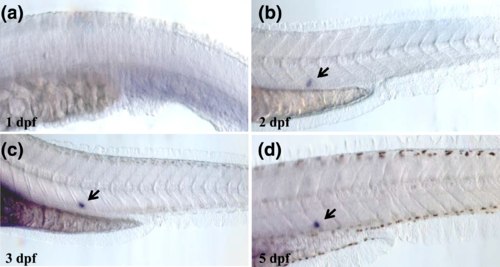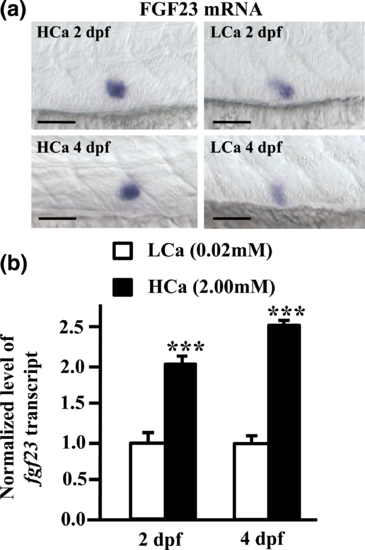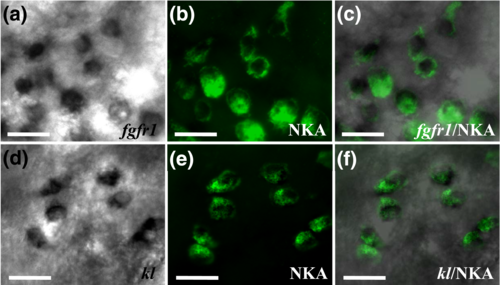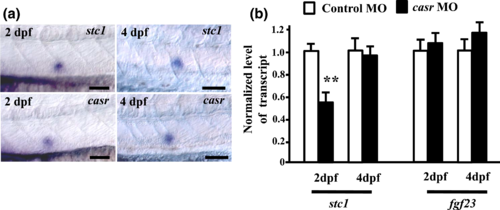- Title
-
Molecular physiology of the hypocalcemic action of fibroblast growth factor 23 in zebrafish (Danio rerio)
- Authors
- Lin, C.H., Hu, H.J., Hwang, P.P.
- Source
- Full text @ Endocrinology
|
Expression of FGF23 mRNA in zebrafish larvae. In situ hybridization was used to detect fgf23 signals at the indicated developmental stages (a) 1 dpf, (b) 2 dpf, (c) 3 dpf, and (d) 5 dpf. Arrows indicate the fgf23 mRNA signal. |
|
Incubation in high [Ca2+] enhances (a) FGF23 mRNA signals and (b) expression levels in 2 and 4 dpf zebrafish larvae. In situ hybridization was used to detect fgf23 signals, and gene expression was analyzed by qPCR (values were normalized to those of β-actin). Student t test, ***P < 0.001. Values are the mean ± SD (n = 6). Scale bar: 50 µm. |

ZFIN is incorporating published figure images and captions as part of an ongoing project. Figures from some publications have not yet been curated, or are not available for display because of copyright restrictions. |
|
In situ hybridization against fgfr1 and kl in yolk sac skin of zebrafish larvae. (a, d) Expression of fgfr1 and kl; (b, e) immunohistochemical staining of ecac-expressing cells using NKA α5 antibody; (c, f) colocalization of NKA with fgfr1 and kl signals. Scale bar: 20 μm. EXPRESSION / LABELING:
|
|
(a) Expression of STC1 and CaSR mRNA signals and (b) effect of casr MO on STC1 and FGF23 mRNA expression in 2 and 4 dpf zebrafish larvae. In situ hybridization was performed to detect fgf23 signals, and gene expression was analyzed by qPCR (values were normalized to β-actin). Student t test, **P < 0.01. Values are the mean ± SD (n = 6). Scale bar: 50 µm. |

ZFIN is incorporating published figure images and captions as part of an ongoing project. Figures from some publications have not yet been curated, or are not available for display because of copyright restrictions. |

ZFIN is incorporating published figure images and captions as part of an ongoing project. Figures from some publications have not yet been curated, or are not available for display because of copyright restrictions. |
|
Specificity and effectiveness of fgf23 MO. Embryos were injected with fgf23 cRNA (with GFP fusion) (A), or coinjected with fgf23 MO and cRNA (B). A B fgf23 MO was used to inhibit translation of zebrafish FGF23. The specificity and effectiveness of the fgf23 MO was confirmed by co-injection with zebrafish fgf23 cRNA (fused to GFP). Zebrafish embryos injected with only cRNAs exhibited GFP signals (Figure 1A), confirming translation of fgf23 cRNA. On the other hand, embryos co-injected with fgf23 MO and fgf23 cRNA showed no green fluorescence (Figure 1B), indicating that the MO specifically and effectively knocked-down the translation of fgf23 mRNA. |





